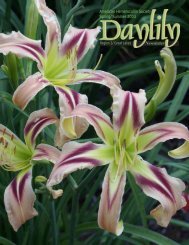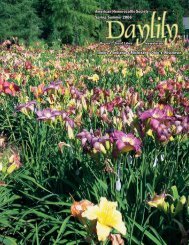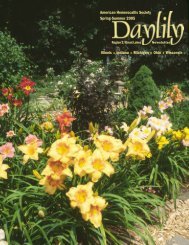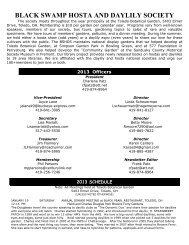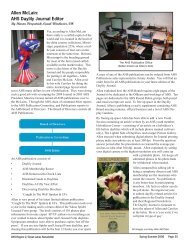Part 1, Pages 1-23 - AHS Region 2
Part 1, Pages 1-23 - AHS Region 2
Part 1, Pages 1-23 - AHS Region 2
Create successful ePaper yourself
Turn your PDF publications into a flip-book with our unique Google optimized e-Paper software.
DOWN and LOVE GODDESS, and a ruffled pink polychrome<br />
HAIL MARY was born.<br />
Full form daylilies were in vogue. No one wanted a skinny petaled,<br />
spider type flower. Steve either composted that type of seedling<br />
or he pawned the undesirables off on a landscaper friend. After<br />
all, he had worked the last thirty years to fatten up the petals, so why<br />
keep the skinnies. A few years ago, daylily enthusiasts began to<br />
notice how tall, thin-petaled daylilies added grace and movement to<br />
a garden. Twenty years later, Steve was able to retrieve one of those<br />
landscaper seedlings, and it has become one of the most popular<br />
daylilies in his garden. Instead of naming this flower<br />
LANDSCAPER’S DELIGHT, the lovely tetraploid lavender unusual<br />
form is known as KYOTO SWAN.<br />
The 1990 Years<br />
In 1990 a smashing purple diploid, GRAND MASTERPIECE,<br />
from Texas hybridizer Bob Dove took the daylily world by storm.<br />
Its color was better than any tetraploid out there. Steve chuckled as<br />
he described how, later, it was confirmed that Dove sort of rustled<br />
the plant from another Texas hybridizer, Jack Carpenter, and put his<br />
own brand on it. A neighboring hybridizer Curt Hanson, with whom<br />
Steve exchanged daylily knowledge, managed to do a successful<br />
conversion on GRAND MASTERPIECE, and he shared a couple<br />
of pollen filled anthers with Steve. Always outcrossing to create<br />
hardier plants, he used the pollen and was able to incorporate another<br />
tough southern gene into his hybridizing program from a plant<br />
that would thrive in a climate as hot as Hades but that would also<br />
take the abuse of the frozen North. COURT MAGICIAN crossed<br />
with tetraploid GRAND MASTERPIECE resulted in wide-petaled,<br />
deep purple NINJA NIGHT. When he crossed STRUTTER’S BALL<br />
melon colored cultivars of Brother Charles Reckamp. Results were<br />
a purple bicolor, which added a new dimension to his purple line,<br />
and he named it FLYING CARPET. Intrigued with eye patterns,<br />
Steve combined the gene pool of Munson’s lavender watermark<br />
EMPEROR BUTTERFLY with FLYING CARPET and came up<br />
with a cultivar he dubbed OLD KING COLE. Steve considers this<br />
one as one of the nicest eyed bicolor cultivars in his program.<br />
By the mid 1990’s, Steve was becoming concerned about the future<br />
of the daylily. Demand was at an all-time high for big, fat, ruffled,<br />
bubbly, multi-edged daylilies, and connoisseurs would pay any price<br />
to get them. Greed was taking over the integrity of growers and<br />
hybridizers. Pretty diploids were being converted without first checking<br />
for plant defects. Inbreeding ran rampant, flashy cultivars were<br />
being mass produced by unnatural process and grown under greenhouse<br />
conditions. Many plants were never kissed by the sun or<br />
brushed by a breath of fresh air before being thrown onto the market.<br />
The daylily world was getting upset because some of these plants<br />
were so weak, they died before being planted in the ground. The<br />
modern daylily was becoming an expensive annual.<br />
On a visit to Moldovan’s Garden a few years ago, an outstanding<br />
flower with a multiple eye pattern jumped out at me while I was<br />
inspecting the seedling field. When I questioned Steve about the<br />
seedling, he said, “I didn’t do it–Tony did.” Tony Slanec was a horticulture<br />
student from The Ohio State University doing graduate<br />
work at the garden and who wanted to learn how to hybridize. Steve<br />
showed him the ropes and turned the young man loose. Tony crossed<br />
one of Steve’s patterned, eyed OLD KING COLE seedlings with<br />
Elizabeth Salter’s tetraploid LADY VIOLET EYES. The match resulted<br />
in a uniquely distinctive seedling with a washed violet eye<br />
pattern that showed every day, no matter what the temperature. This<br />
Image: Roy Woodhall<br />
FRIAR’S LANTERN<br />
(STRUTTER’S BALL X TET GRAND MASTERPIECE)<br />
OLD KING COLE (Image: Roy Woodhall)<br />
with the potent pollen from MEPHISTOPHELES, a dark violet<br />
purple materialized. NOBLE LORD was a result of taking<br />
MEPHISTOPHELES pollen to FENCING MASTER. A grape colored<br />
flower with a white edge named SHAKA ZULU came from<br />
crossing MEPHISTOPHELES with COURT MAGICIAN. Outcrossing<br />
the MEPHISTOPHELES seedlings to his older line produced<br />
a white edge on dark purple WATERSHIP DOWN and the<br />
frilly, white edged, deep purple VATICAN CITY.<br />
Steve noticed a slight multiple eye pattern in a seedling from<br />
STRUTTERS BALL and tetraploid GRAND MASTERPIECE, that<br />
he named FRIAR’S LANTERN. The eye pattern did not show every<br />
day, but when it did there was something different about the<br />
flower. Starting to explore the possibilities of the eye pattern in<br />
FRIAR’S LANTERN, he took its pollen to strong, multibranched,<br />
Page 18 Spring-Summer 2004<br />
DIGITAL<br />
IMAGERY<br />
(Image: Roy<br />
Woodhall)<br />
<strong>AHS</strong> <strong>Region</strong> 2/Great Lakes Newsletter



